Features and types of coasters for strawberries
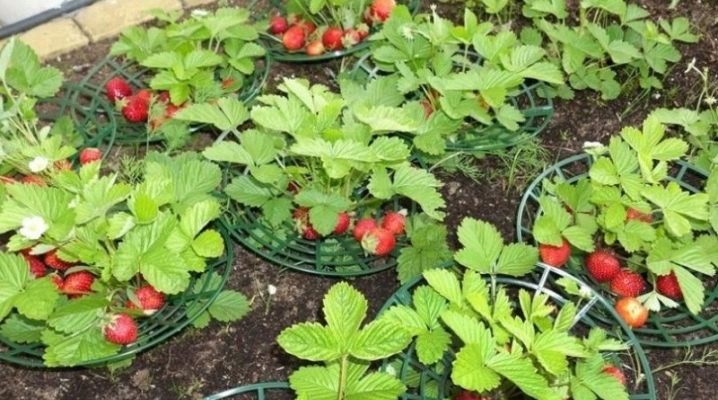
Strawberries release whiskers and rosettes, a little time passes and the area with well-planted rows turns into a homogeneous plant mass. After the rain, the berries turn out to be in the mud, they rot from contact with the ground. If you install a bush holder under each bush, the plant will be clean, healthy, with a lot of juicy fruits.
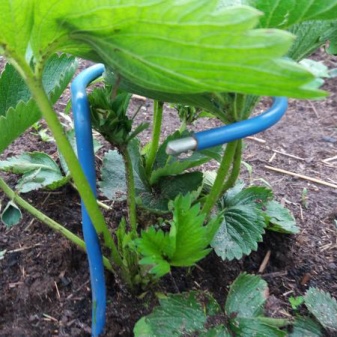
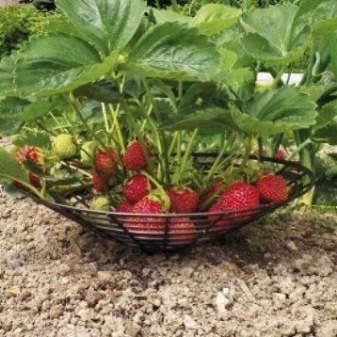
General description and purpose
A strawberry stand is a simple, often home-made device that can support bushes with heavy ripening berries and save them a lot of trouble.
Bush holders can be made of plastic, metal, wire, wood, rubber. They look different.
The devices are tried to be introduced under the bush at an early stage of plant development. A huge overgrown bush will already be difficult to hoist on a saving structure.

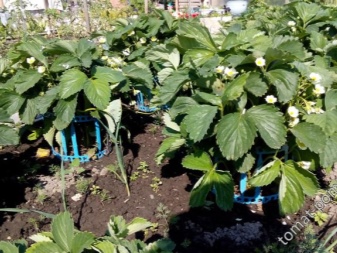
The abundance of coasters in a strawberry patch may seem like a waste, but the benefits of them are obvious:
- berries do not have contact with the soil and do not rot;
- the crop is always clean, has an excellent presentation;
- the bushes are raised above the root system and are well ventilated;
- plants are less susceptible to diseases, pathogens of which are in the soil;
- the stand prevents snails and slugs from getting to ripe berries and spoiling the harvest;
- a raised bush is closer to the sun, ripens faster;
- picking berries from clean, well-marked bushes is much easier than from a regular garden.
The disadvantages of strawberry props include material costs, as well as the labor and time spent on their manufacture and installation.
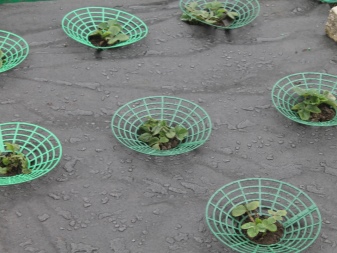
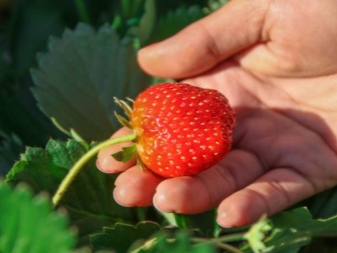
Varieties
In hardware stores (gardeners' sections), you can find factory fixtures to support strawberry bushes. They look civilized, but you have to pay for them. The plus of buying is that a reusable design is purchased... It can be removed at the end of the season and reinstalled the next year. Those who consider such expenses wasteful make the devices themselves.

First, let's look at the factory types of supports.
Wire construction
The simplest and most budgetary support made of stiff wire. It is a circle, fixed on a holder, which is inserted into the soil to the required level. The plant is laid out neatly over the circle. This support is easy to make yourself.
The design is recommended for young bushes. Under the weight of berries, adult powerful plants bend over the wire ring and break the flower stalks.
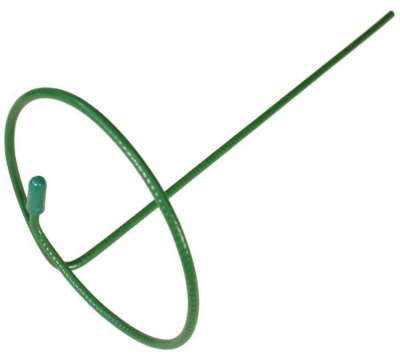
Plastic rings
Plastic supports work on the principle of wire options, and they are even cheaper... The structure is a plastic circle with three support legs. The diameter of the circle is adjustable, which allows it to be used for younger and more mature bushes. The legs are driven into the ground to the desired height.
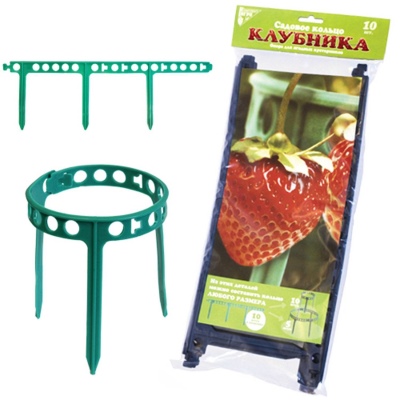
Spiral supports
The structure is made of rigid wire in the form of a flat spiral ring... In the soil, it rests on two supports emanating from the beginning and end of the spiral. This holder is suitable for bushes of all sizes. It allows air to pass through well and gently supports the plants without breaking the stems.
The only problem may be berries that get stuck between the turns of the spiral.
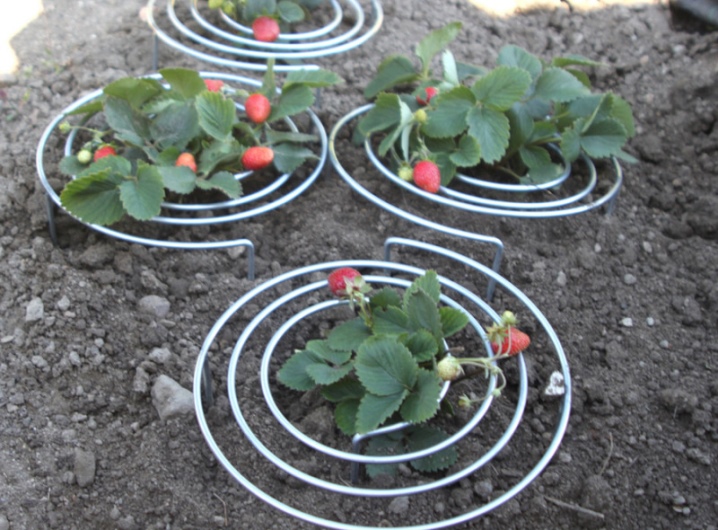
Support circles
The more expensive and most practical products. They look like mesh circles, are installed on props.The circles consist of two parts, which allows them to be worn on a strawberry bush at any age. The berries do not fall through as the mesh has small cells. The whole bush is well ventilated and lies comfortably on a stand, raised to the sun.

"Fence"
A fence-shaped support is installed and snaps into place around the bush. Thanks to the adaptation, the plant gathers in a bunch and rises up without touching the soil surface.
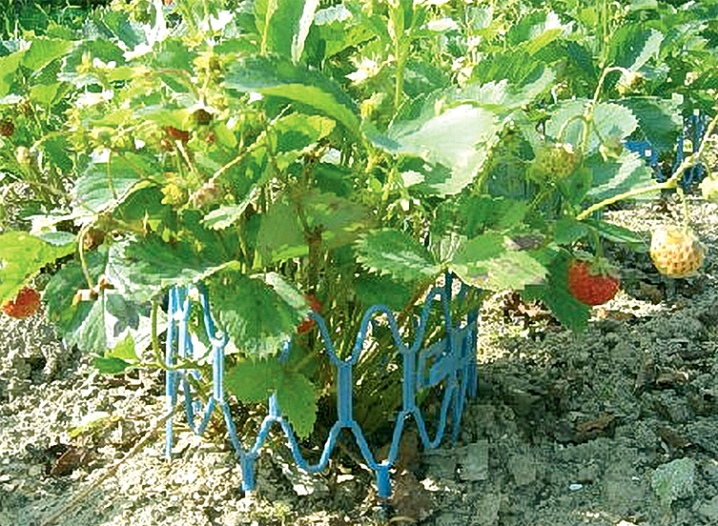
Geogrid
Purchased geogrid blanks operate according to the same principle. They come complete with plastic clips. A net installed around the plant keeps it upright and protects the berries from contact with the ground.
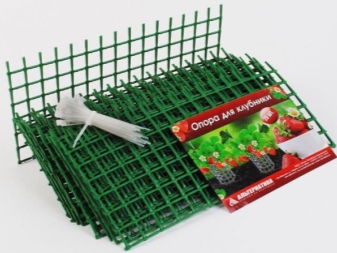
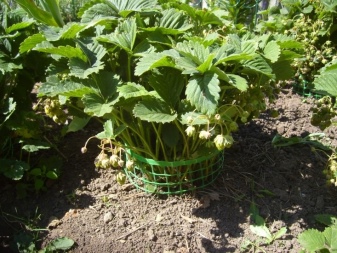
Gardeners surprise with their unlimited imagination, they make strawberry supports from various household items.
Plastic bottles
A large plastic bottle is cut in a circle on both sides, turning the product into a kind of pipe. At one end, incisions are made up to 7 cm deep with a step between them of about 4 cm. The resulting "petals" are bent outward. The strawberry bush is carefully introduced into the workpiece so that the cuts are on top. The "petals" of the stand prevent the plant from being squeezed against the sharp edges of the cut bottle.
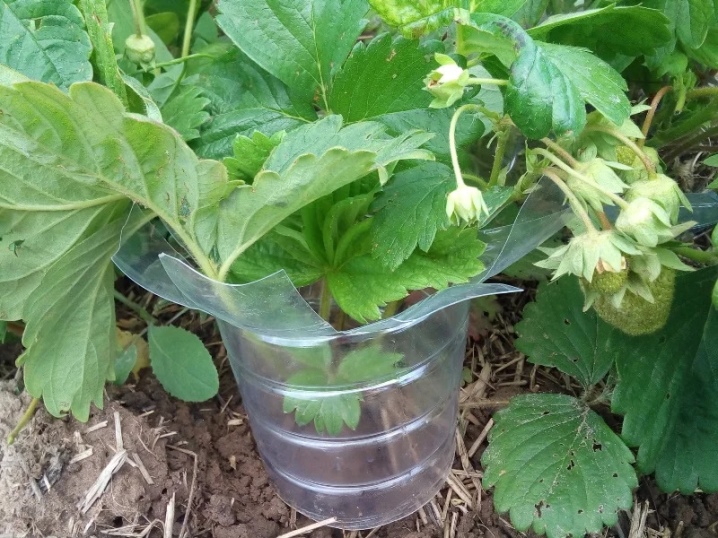
There is a second option. Cut off the bottom of a five-liter bottle up to 15 cm high. Cut out the bottom so that a bush can be placed in this hole. On the opposite side, corners of 7 cm in length are cut in a circle, with their help the structure enters the soil more easily. But you can not do this, but simply press the workpiece more tightly to the ground.
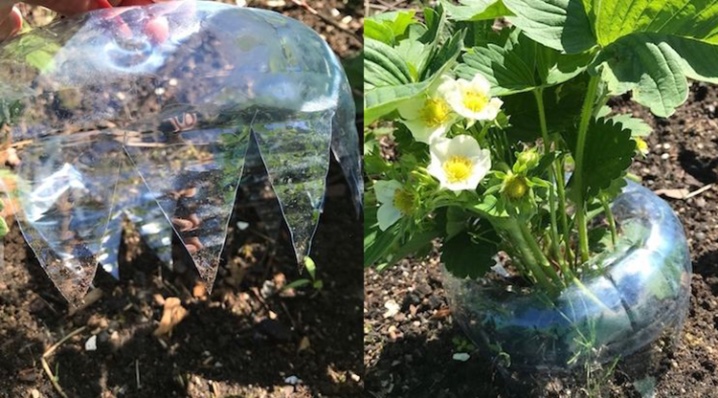
Wire at home
Gardeners make supports for strawberries from thick, strong wire in different ways. Most often, a semicircle is performed with support legs lowered on both sides, which are introduced into the soil. Placing two blanks side by side, they form a full circle on which the strawberry bush rests.

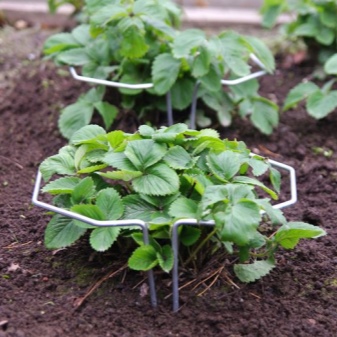
Disposable plates
The simplest devices for keeping strawberries healthy and clean are ordinary disposable plates. A circle is cut out in the center of the product, a bush is introduced into it. The method is inexpensive in terms of cost and manufacturing effort, but not very practical. Dishes lying firmly on the ground do not provide adequate air circulation.
In addition, over time, the overgrown bush throws out horns and flower stalks with fruits outside the plate, which fall not on the support, but on the ground.
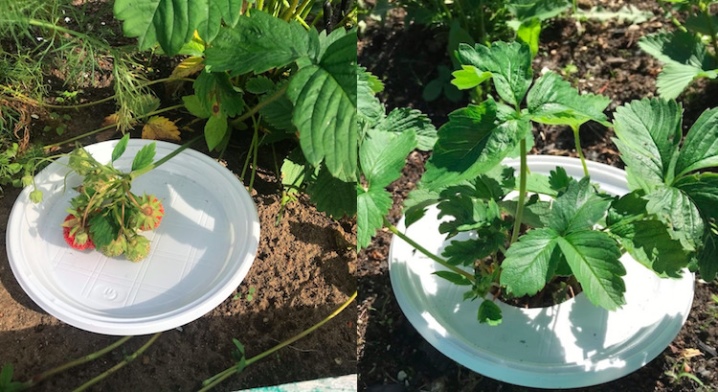
Plastic forks
For plastic forks, remove the central teeth, leaving only the outer ones, between which a branch with fruits is laid. In this case, the fork is installed vertically, dropping it into the soil. The holder is not very strong, it lasts until the first wind or before jogging along the bed of the animal. In addition, a large number of forks will be needed.
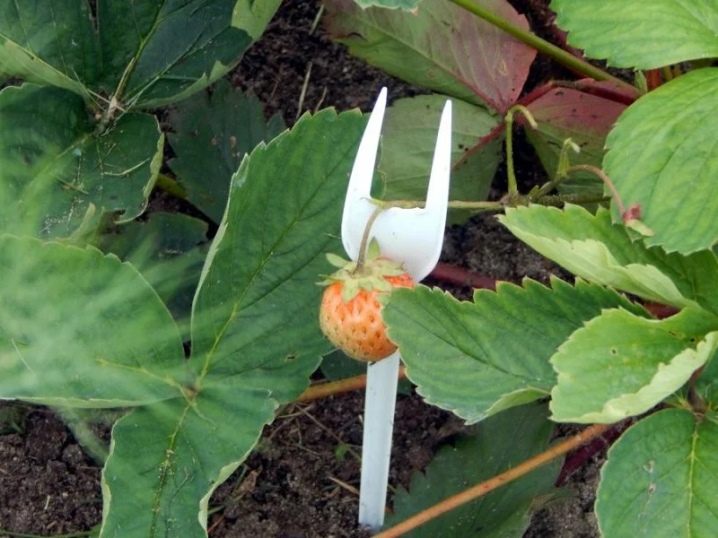
Plank construction
Strawberries can be grown in the gaps between old planks that have been knitted together into a single structure. Environmentally friendly material will not cause trouble for plants, and flower stalks with pouring berries will lie not on the ground, but on dry and clean boards.
Having old wood available, no costs, except labor and time for the manufacture of the device, will be needed.

Film
It is convenient to use film or agrofibre on a large scale, when it is impossible to install supports under each bush. The bed is completely covered with a covering material, in which holes for the plants are cut. Strawberries are kept dry and clean on film.
In such conditions, it is easy to follow the culture, remove unnecessary shoots, mustache with rosettes in time, it is convenient to form large isolated bushes.
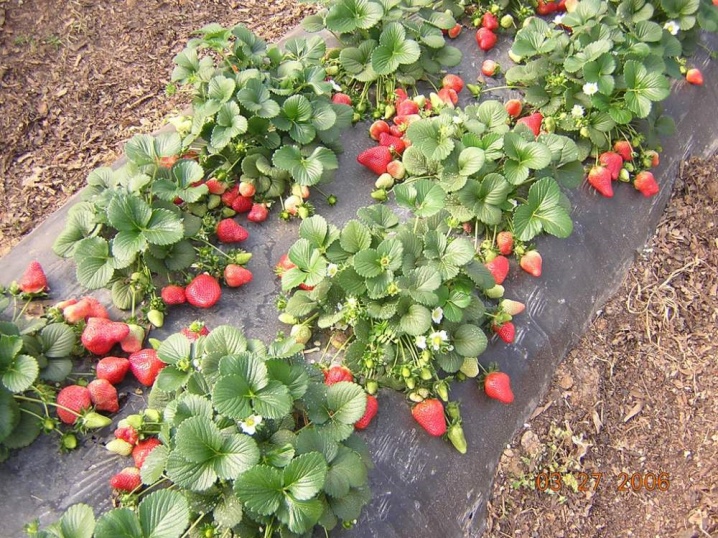
Branches
A simple and environmentally friendly way is to make ordinary spears from branches using a pruner.... They are installed under each bush and the flower stalks of plants are placed between the branches. This care of strawberries requires painstaking and lengthy preparation, but without material costs.Devices made from natural material (twigs) ultimately give their positive results.
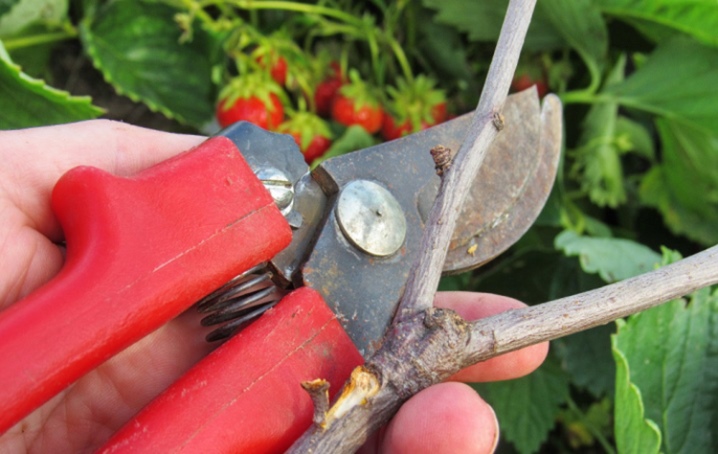
Mulch
Natural bedding for strawberry bushes allows the roots to breathe, does not retain moisture on the surface, but lets it into the soil. The fruits do not come into contact with the ground, lie on dry and clean sawdust, straw or cut grass. After decomposition, the mulch turns into a useful organic fertilizer.

How to make a support with your own hands?
As we have already seen, domestic gardeners and gardeners do not run out of ideas for making tools and growing healthy strawberries. The main thing in the device of the stand is the supporting elements for the plant itself and the stand, which reliably and firmly enters the ground. We offer several master classes on making strawberry supports.
Option 1
To perform the simplest device, you need a wire with a cross section of up to 8 mm, strong, but with the ability to bend. You should prepare a sewer pipe or part of it with a diameter of up to 20 cm, as well as pliers.
Then the following actions are performed:
- the wire is wrapped around one of the sides of the pipe, forming a loop;
- with pliers, bend the ring from the remaining wire at a right angle;
- leave a rack of the required size, the rest of the material is cut off from the stand.
Three simple steps - and the strawberry holder is ready. It remains only to install it near the bush, driving the support into the ground, and spread the plant over the loop.

Option 2
Small strawberry beds can be made from materials left over from repairs (planks and planks). For work, you will need 4 meter boards 10 cm wide, 6 meter strips, a hammer and nails or screws.
- A box (1x1 m) is assembled from the boards with the help of nails or self-tapping screws. The joints can be reinforced with glue for strength or reinforced with building corners.
- With a step of 25 cm, strips are mounted on the box, they are fixed with nails (4 pieces on each side). It turns out a bed with sixteen squares.
Several such devices can be made and installed in the yard for decoration. Peat is laid at the bottom of the structure, then slightly acidic soil is poured, which has undergone antiseptic treatment and fed with fertilizers. 16 seedlings are planted in each stand. This design has a dual function: it is beautifully decorated and promotes a healthy strawberry harvest.
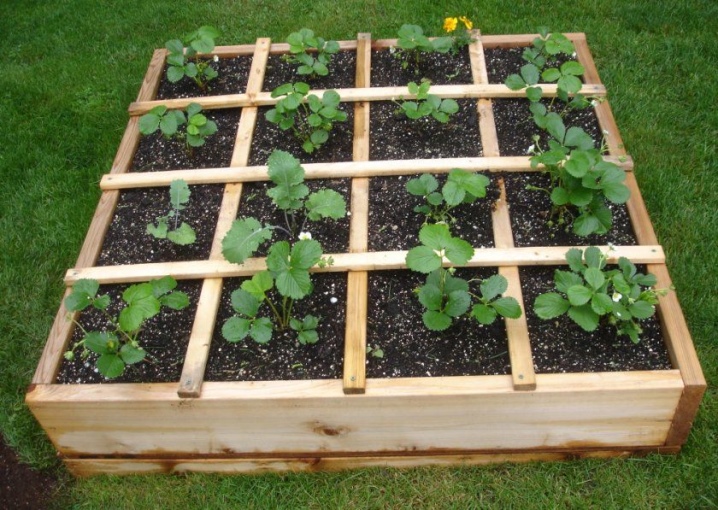
The harvest of juicy tasty berries can be harvested without coasters for strawberries, but its loss due to pathogenic microbes and fungus will be 20 to 40 percent.
For an overview of the strawberry stand, see the next video.













The comment was sent successfully.